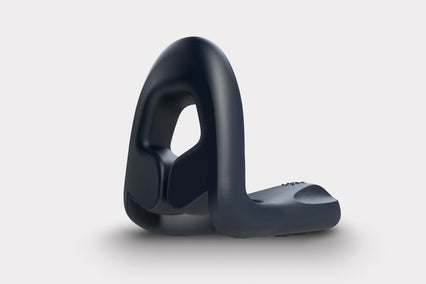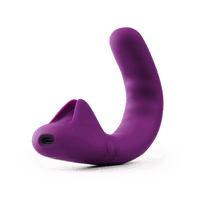Written by: Somatic Sexologist and Sex & Intimacy Coach Alice Child
Female sexual arousal is a broad and nuanced topic, starting with the fact that every woman and vulva owner will have different turn-ons and different sex drives. All of us experience changes in our desire - or our bodies' responses to arousal - throughout our lives. Although the waning and waxing of our sex drive is normal, it can be frustrating or disempowering when we experience sexual difficulties. How we express ourselves sexually is a big part of who we are, and without it we might feel less confident, less fulfilled in our relationships, or less connected to our own bodies.
When this decreased or lack of interest in sex becomes persistent and distressing, it can be called Sexual Interest/Arousal Disorder. Although it can feel isolating and frustrating, it is treatable. Lifestyle changes, support from medical professionals, education, and sex and intimacy coaching can all help us to reconnect with our sexual desire and prioritize our pleasure.
This article explains everything you need to know about Female Sexual Arousal Disorder, how to spot it, and what to do if you think you might have it.

What is Female Sexual Interest/Arousal Disorder?
Before we get into what female sexual arousal disorder is, it’s important first to understand the role of arousal in the body and how it contributes to sexual response. There are four stages of arousal in the body:
- desire (wanting sex/intimacy)
- arousal (building the excitement)
- orgasm (peak of pleasure) and
- resolution (sexual satiation)
Desire can be ‘spontaneous’ - when you feel the mental desire first - or ‘responsive’ - when you need a bit more time and/or stimulation to build desire in your body. Both are healthy and normal responses.
However, not everyone goes through all these phases in the same order, and it’s rarely a smooth journey from ‘desire’ to ‘orgasm’. Some women experience plateaus or dips in arousal, and sometimes it just doesn’t build up the way they wish it would.
Female Sexual Arousal Disorder (FSAD), now called Female Sexual Interest/Arousal Disorder (FSIAD) in the DSM-5, is an absence of or a low level of sexual interest and/or desire. This can mean a decreased interest in sexual activity, thoughts, fantasies, and even pleasure. Some women find they don’t respond to physical or genital stimulation or cannot become aroused with sufficient sexual stimuli.
Although experiencing a decreased interest in sex and a decrease in the ability to be sexually aroused over time is normal, people experiencing FSAD experience greater changes than what might be expected based on their age and life circumstances.
It’s important to note that arousal issues are only considered a sexual dysfunction if it causes distress to the person experiencing these symptoms, the symptoms have been persistent for over 6 months, and sexual stimulation (genital or otherwise) doesn’t do anything to increase desire, pleasure, or arousal. While the term sexual dysfunction can sound intimidating, it’s actually quite common. Over 40% of women experience some form of sexual dysfunction (including FSIAD) during their lifetime.
The symptoms of female sexual arousal disorder share some overlap with asexuality and can sometimes be confused, but the two are different things entirely. Asexuality is a sexual identity or orientation characterized by a lack of sexual attraction to others and little or no desire to engage in sexual activity, but generally doesn’t cause distress and is not a dysfunction or medical condition.

Types of Female Sexual Arousal Disorder
Depending on how your body and mind respond during sexual stimulation, decreased sexual arousal can be defined as subjective, genital, or combined:
- Subjective: When you do not feel aroused by any type of sexual/genital touch or non-genital stimulation (e.g. kissing, reading erotica, watching porn, erotic massage). Your body might physically respond (e.g. becoming wet / becoming engorged), but you don’t feel pleasure.
- Genital: When you feel aroused by non-genital stimulation (e.g. kissing, watching porn) but don’t enjoy genital touch and stimulation. This is most common with menopausal women. This is because menopause can cause vaginal dryness and increased vulva sensitivity, meaning certain types of genital stimulation might no longer feel as pleasurable.
- Combined: When you don’t feel aroused by any type of sexual stimulation (physical or mental), and you also notice that your body isn’t responding to arousal (e.g. reduced wetness/lubrication and less engorgement, swelling, or sensation)
Symptoms of Female Sexual Arousal Disorder
Symptoms of FSIAD may come and go, and not everyone experiences them all or in the same way. Some of the common symptoms you might notice include:
- Decreased sexual desire: You have lost interest in sex and feel less arousal/desire.
- Having less sex: You are engaging less in sexual activity and not needing or wanting it as often (or at all).
- Few sexual thoughts: You don’t think about sex often, including thoughts or sexual fantasies.
- You don’t initiate sex: You don’t tend to initiate sex and may be reluctant to engage with a partner when they try and initiate sex.
- Decreased pleasure during sex: Sexual stimulation and intimacy don’t feel good, and the things that used to turn you on no longer do.
- Reduced sensations: You don’t feel that your genitals or erogenous zones are as sensitive or pleasurable during sex or intimacy.
- Reduced arousal from external or internal stimulus: Things that used to turn you on - like reading erotica, oral sex, or remembering a hot sex session - no longer do.
If these symptoms are worrying you, it might be time to get some support. You do not need to suffer alone and in silence, and there are things you can do to increase your desire, libido and sexual pleasure.

Causes of Female Sexual Arousal Disorder
Sexual health is intrinsically linked with physical and mental health. There are many factors that impact sexual desire and arousal that might make it harder to enjoy and experience pleasure.
Psychological and emotional causes
When we are stuck in our heads or experiencing a lot of mental distractions, it can be hard to drop into our bodies and experience desire, pleasure, arousal, and sensation.
Emotional and mental health concerns that can lead to lower arousal and desire include:
- Low self-esteem, body image or self-confidence
- Stress, anxiety or depression
- Relationship problems (e.g., lack of intimacy, connection, or trust)
- Sexual communication issues (e.g., not being able to talk about sex and communicate what we like)
- Negative thoughts or distractions
- Sexual shame e.g., guilt, embarrassment or not feeling like you ‘deserve’ pleasure
- Sexual trauma
- Insomnia or trouble sleeping
- Medications e.g., certain antidepressants affect your sex drive
Hormonal changes
Hormones have a huge impact on our mood, social connection and how arousal builds in our body. Although everyone’s experiences are different, things that cause ongoing hormonal changes can therefore affect our arousal and desire, including:
- Menopause
- Hormonal Contraception e.g. the pill, the implant, injections, the hormonal IUD
- Pregnancy and childbirth
Physical Causes
Some possible physical causes:
- Gut health and diet – Our gut plays a critical role in controlling our mood. 90% of our serotonin supply is made in the gut. If our gut health is off, our sexual health usually follows.
- Surgery or scar tissue in the abdomen or pelvis -e.g. from a cesarean or pelvic surgery. This can also lead to sexual pain and discomfort.
- Reduced blood flow to the vulva and vagina
- Nerve damage in the pelvis
- Infection of the vagina or bladder - e.g. UTIs and STIs
- Thinning, drying vaginal tissues - e.g. through menopause
- Diabetes can affect your nervous and vascular systems. This may make arousal more difficult because your body is unable to send the necessary hormones, blood, and electrical signals for arousal.
Female Sexual Arousal Disorder Treatments
Depending on the cause of your FSIAD, the support you need will be different. Consider any major changes in your life and when you started experiencing lower desire and see if you can identify any patterns. For example, are you going through menopause, postpartum, post-abdominal surgery, changing medications, stressed with interpersonal relationships, or on new contraception? If so, consider seeing an appropriate specialist.
Some example treatments could include:
- Therapy or couples counseling
- Changing your medication
- Going onto a non-hormonal contraception
- Sexual therapy, whether seeing a sexologist or talking to a sex therapist
- Hormone therapy via a menopause specialist / GP
- Vaginal dryness treatments and lubes
- Diabetes treatments
- Nutritional support and diet planning
- Pelvic physiotherapy
- Scar work and remediation
- Vibratory stimulation

If you think your FSAD is caused by emotional and/or sexual (rather than physical or hormonal) causes, other treatment avenues may include:
Educate yourself using sex-positive resources
Go out and learn as much as you can about sex, pleasure and bodies. Find the resources that work for you, whether that’s podcasts, books, online courses, workshops or seeing a sex coach. Surround yourself with expert-led, sex-positive, body-positive, up-to-date sexual education, and challenge your own assumptions and beliefs about sexuality that might be holding you back.
Use a vibrator
While you may consider vibrators to be novelty items or sex toys, vibratory stimulation has been shown to increase sexual desire and overall sexual function. When vibrations are applied to the genital region, it promotes vasodilation and increases circulation in the pelvic floor and surrounding areas, thereby enhancing sensation and arousal. For women, using a vibrator can also increase the likelihood of orgasm, and multiple orgasms. The best part of using a vibrator is that there aren’t any negative side effects like certain prescription medications. And when proactively designed, vibrators can be classified by the FDA as medical devices to treat certain sexual dysfunctions, such as Crescendo 2. Health can also be sexy.
Get back to pleasure instead of pressure
FSAD can be stressful and frustrating, and these emotions usually lead to a negative spiral. Stress is not an aphrodisiac! Instead, try and remove the goal of sex/orgasm, which admittedly can feel difficult when navigating sex drive differences in your relationship. Instead focus on feeling safe, calm, and more connected to your pleasure. Try and schedule time every day for some form of self-pleasure practice – even if it’s just a hot, steamy shower or feeling the sun on your face. Create a sensual space and a mindset - whether that’s candles, incense, fresh bedding, or music. Think of these as your sexy ‘accelerators’. Then do the opposite and identify what makes you feel distracted or disconnected during sex. Think of these as your ‘brakes’. Do what you can to reduce them in your space – for example, you might turn off your phone.
Try new things
It’s very normal for us to fall into habits when it comes to sex and pleasure. Over time, the same things stop working as well or sex can feel boring and predictable. If that sounds familiar, it’s time to get active about prioritizing your pleasure. Be curious and try new things such as an adrenaline-filled date or a new sex toy like a G-spot vibrator or vibrating cock ring.
Practice sexual communication
Be explicit and clear with your sexual communication – ask for what you want, be descriptive, and learn together. Know that you won’t always get it right – and that’s okay! But create a safe space for experimentation, learning, and play in your sex life.
Sexual Mindfulness
If you find your mind wanders during sex and it’s hard to stay present and in the moment, this blocks arousal being able to build. Sexual meditation can be a great tool for getting us out of our head and into our bodies. During sex or self-pleasure, try placing your attention on the physical sensations you are experiencing – what are you noticing physically in your body? How does the touch feel?
Masturbate more, and with more variation
A 2017 study found that only 40% of women masturbate. If you don’t explore your body, how will you discover what you like? If you don’t know what you like, how do you tell your lover what feels amazing? Stay curious, change it up, and see what else you discover. Not only will masturbation teach you about your body, but it has numerous secondary benefits such as better sleep and reduced anxiety (which also enhance your ability to experience pleasure!)

Many women will experience some form of reduced desire, arousal, or sexual pleasure in their lifetime. Remember you are not alone, and what you are experiencing is normal. Be patient and kind to yourself, but do not feel like you need to find your mojo alone. Seek out any professional or medical support you might be needing and try and communicate openly and honestly with your partner.















































